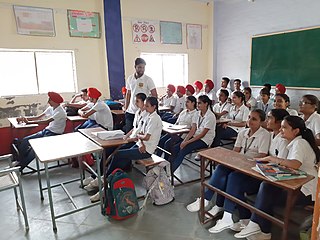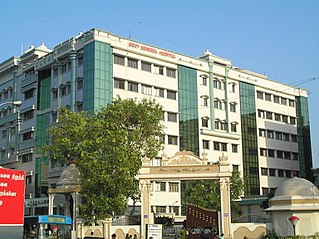India's telecommunication network is the second largest in the world by number of telephone users with 1179.49 million subscribers as on 31 January 2021. It has one of the lowest call tariffs in the world enabled by mega telecom operators and hyper-competition among them. India has the world's second-largest Internet user-base with 747.41 million broadband internet subscribers in the country.

Education in India is primarily managed by state-run public education system, which fall under the command of the government at three levels: central, state and local. Under various articles of the Indian Constitution and the Right of Children to Free and Compulsory Education Act, 2009, free and compulsory education is provided as a fundamental right to children aged 6 to 14. The approximate ratio of public schools to private schools in India is 7:5.
The television industry in India is very diverse and produces thousands of programs in many of the Indian languages. More than half of all Indian households own a television. As of 2016, the country had over 857 channels of which 184 were pay channels. The Hindi, Telugu and Tamil language television industries are by far the largest television industries in India.
Studying abroad in the United States is the act of a student pursuing educational opportunities in the United States. This can include primary, secondary and post-secondary students. Studying abroad is determined in the United States by political rationales of national security and foreign policy. The number of students studying abroad represents only about 1% of all students enrolled at institutions of higher education in the United States.

University Grants Commission (UGC) is a statutory body set up by the Department of Higher Education, Ministry of Education, Government of India in accordance to the UGC Act 1956 and is charged with coordination, determination and maintenance of standards of higher education in India. It provides recognition to universities in India, and disbursements of funds to such recognized universities and colleges. The headquarters are in New Delhi, and it has six regional centres in Pune, Bhopal, Kolkata, Hyderabad, Guwahati and Bangalore. A proposal to replace it with another new regulatory body called HECI is under consideration by the Government of India. The UGC provides doctoral scholarships to all those who clear JRF in the National Eligibility Test. On an average, each year ₹725 crore (US$91 million) is spent on doctoral and post-doctoral fellowships by the commission.

All India Institute of Medical Sciences, New Delhi, also known as AIIMS Delhi, is a public medical research university and hospital in New Delhi, India. The institute is governed by the AIIMS Act, 1956 and operates autonomously under the Ministry of Health and Family Welfare.

The All India Council for Technical Education (AICTE) is a statutory body, and a national-level council for technical education, under the Department of Higher Education. Established in November 1945 first as an advisory body and later on in 1987 given statutory status by an Act of Parliament, AICTE is responsible for proper planning and coordinated development of the technical education and management education system in India.

Vedanta University is a proposed, private, multi-disciplinary, co-educational university to be started by Anil Agarwal of Vedanta Resources corporation near Puri-Konark highway, Odisha, India. According to the news reports and as of Sep 2010, the plans of the university was a closed chapter. However, in late April 2015 a revival of the project was initiated; The ex-Chief Secretary of Odisha, Mr. Bijay Patnaik, was hired as the President of the Vedanta University Project to revive this project.
Indian Institutes of Science Education and Research (IISERs) are a group of premier public research institutions in India. The institutes were established by the Government of India through the Ministry of Human Resource Development (MHRD) to provide collegiate education in basic sciences coupled with research at the undergraduate level. The institutes were formally established by the Parliament of India through the National Institutes of Technology, Science Education and Research (Amendment) Act, 2010. Seven IISERs have been established across the country, namely IISER Kolkata in West Bengal, IISER Pune in Maharashtra, IISER Mohali in Punjab, IISER Bhopal in Madhya Pradesh, IISER Thiruvananthapuram in Kerala, IISER Tirupati in Andhra Pradesh, and IISER Berhampur in Odisha. All IISERs were declared as Institutes of National Importance by the Parliament of India in 2012, to promote them as leading institutions in the country in the field of basic sciences along with its sister institutes like Indian Institute of Science, Bangalore and National Institute of Science Education and Research, Bhubaneswar. The financial outlay for each IISER is around ₹5 billion (US$63 million) for the first five years of establishment.

Indira Gandhi National Open University, known as IGNOU, is a Central University located at Maidan Garhi, New Delhi, India. Named after former Prime Minister of India Indira Gandhi, the university was established in 1985 with a budget of ₹20 million, after the Parliament of India passed the Indira Gandhi National Open University Act, 1985. IGNOU is run by the central government of India, and with total active enrollment of over 4 million students, it is the largest university in the world.
Manufacturing in Mexico grew rapidly in the late 1960s with the end of the US farm labor agreement known as the bracero program. This sent many unskilled farm laborers back into the Northern border region with no source of income. As a result, the US and Mexican governments agreed to The Border Industrialization Program, which permitted US companies to assemble product in Mexico using raw materials and components from the US with reduced duties. The Border Industrialization Program became known popularly as The Maquiladora Program or shortened to The Maquila Program.
Previously a neglected aspect of the Indian Central government, Education in Odisha is witnessing a rapid transformation. Its capital city, Bhubaneswar, is emerging as a knowledge hub in India with several new public and private universities, including the establishment of an Indian Institute of Technology after five decades of demand.

Retailing in India is one of the pillars of its economy and accounts for about 10 percent of its GDP. The Indian retail market is estimated to be US$ 600 billion and one of the top five retail markets in the world by economic value. India is one of the fastest growing retail markets in the world, with 1.2 billion people.

Nalanda University is a public central located in Nalanda district's Rajgir in the state of Bihar, India. It is designated as an Institute of National Importance (INI) and excellence. The international university supported by 18 member countries was established by an Act of the Indian Parliament in 2010. The decision to set up the university was endorsed at the second and fourth East Asia Summits. The President of India serves as Visitor to the university.
Bharat stage emission standards (BSES) are emission standards instituted by the Government of India to regulate the output of air pollutants from compression ignition engines and Spark-ignition engines equipment, including motor vehicles. The standards and the timeline for implementation are set by the Central Pollution Control Board under the Ministry of Environment, Forest and Climate Change.
Direct-to-Home (DTH) television is a method of receiving satellite television by means of signals transmitted from direct-broadcast satellites. The Government of India (GoI) permitted the reception and distribution of satellite television signals in November 2000. The first DTH service in the country was launched by Dish TV on 2 October 2003. DD Free Dish, the first free DTH service in India, was launched by public broadcaster Prasar Bharati in December 2004.

Healthcare in Chennai is provided by both government-run and private hospitals. Chennai attracts about 45 percent of health tourists from abroad arriving in the country and 30 to 40 percent of domestic health tourists. The city has been termed India's health capital. Multi- and super-specialty hospitals across the city bring in an estimated 150 international patients every day. Factors behind the tourists' inflow in the city include low costs, little to no waiting period, and facilities offered at the speciality hospitals in the city.
Indian Defence University (IDU), formerly Indian National Defence University (INDU) is a defence service university set up for the affiliation of training academies of union government defence servants working under the Government of India. These union government defence servants can collectively be termed as generalist branch and specialist branch of the Indian Military. It is not to be confused with the Rashtriya Raksha University (RRU) which is focused on the police and para-military Central Armed Police Forces (CAPF), whereas IDU is focused on the military. It is located at Binola village in Gurugram district of Haryana state in India that is being built. It is proposed to be one of the Institutes of National Importance (INIs).
A foreign direct investment (FDI) is an investment in the form of a controlling ownership in a business in one country by an entity based in another country. It is thus distinguished from a foreign portfolio investment by a notion of direct control. Broadly, foreign direct investment includes "mergers and acquisitions, building new facilities, reinvesting profits earned from overseas operations, and intra company loans". FDI is the sum of equity capital, long-term capital, and short-term capital as shown in the balance of payments. FDI usually involves participation in management, joint-venture, transfer of technology and expertise. Stock of FDI is the net cumulative FDI for any given period. Direct investment excludes investment through purchase of shares.
The National Education Policy of India 2020, which was started by the Union Cabinet of India on 29 July 2020, outlines the vision of new education system of India. The new policy replaces the previous National Policy on Education, 1986. The policy is a comprehensive framework for elementary education to higher education as well as vocational training in both rural and urban India. The policy aims to transform India's education system by 2030.








